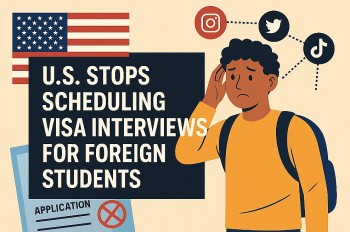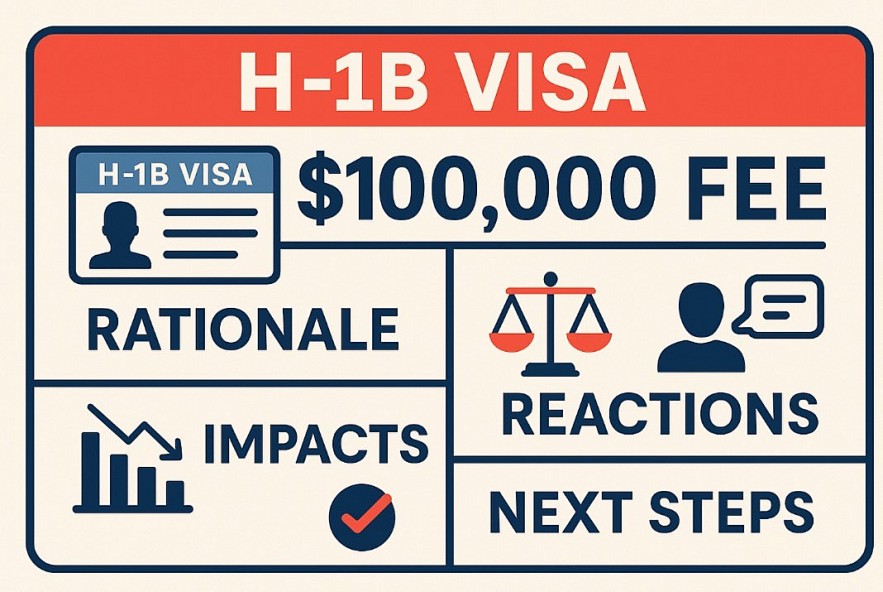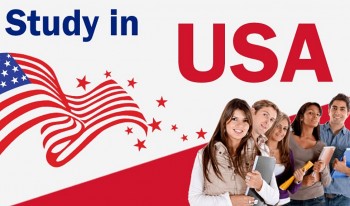H‑1B Visa $100,000 Fee: What It Means, Who’s Affected, and Why It Matters
 U.S. Halts Student Visa Interviews: What This Means and How to Prepare U.S. Halts Student Visa Interviews: What This Means and How to Prepare |
 How Many Chinese Students Are in the U.S.? Latest Numbers, Visa Crackdowns, and What’s Next How Many Chinese Students Are in the U.S.? Latest Numbers, Visa Crackdowns, and What’s Next |
The United States has introduced a game-changing policy in the H‑1B visa program: a $100,000 annual fee for companies seeking to sponsor foreign workers.
This move—signed into law by President Donald Trump on September 19, 2025—marks the most radical overhaul of high-skilled immigration policy in over two decades.
But what exactly does this new rule entail? Why is it being enforced now? And what ripple effects will it have across the U.S. economy, labor market, higher education, and the global talent ecosystem?
Let’s break it down.
Read more: How H‑1B Visa Changes Impact International Students in 2025/2026
 |
| The new $100,000 annual fee for H‑1B visas is changing how U.S. companies hire foreign workers |
What Is the New H‑1B Visa Fee?
The new rule imposes an annual $100,000 fee for each H‑1B visa petition submitted by U.S. employers. This applies to both new applications and renewals, regardless of company size or industry. In addition, petitions not accompanied by this fee will be restricted or outright denied under the current executive proclamation.
This fee is in addition to existing costs, which already include legal fees, USCIS processing charges, anti-fraud fees, and training contributions—bringing the total cost per H‑1B employee to well over $110,000 annually for most firms.
Policy Goals and Political Motivation
The administration frames this change as a corrective action against abuse of the H‑1B system, particularly by outsourcing firms and companies that hire foreign workers at below-market rates.
Key objectives include:
-
Protecting U.S. jobs by reducing competition from lower-paid foreign workers.
-
Prioritizing high-paid, highly skilled workers by pricing out entry-level sponsorships.
-
Reducing dependence on visa programs as a “cheap labor loophole.”
Politically, the policy aligns with rising nationalist sentiment and ongoing concerns about stagnant wages in tech-adjacent industries. It also gives the administration a platform to claim strong action on immigration during an election cycle.
How Employers Are Responding
Big Tech: Calculating the Costs
Large corporations like Google, Microsoft, Amazon, and Meta—which collectively sponsor tens of thousands of H‑1B employees annually—are in strategy mode. While they can afford the added cost, they’re likely to cut back on early-career hires and reallocate budgets toward only senior or niche talent with a high return on investment.
There is growing concern that this move could slow down product development cycles, especially in emerging technologies like AI, quantum computing, and biotech—fields where top global talent remains in short supply.
Startups and SMEs: Facing a Wall
Smaller companies and startups will bear the brunt of this policy. Unlike tech giants, they often rely on a few key H‑1B hires to scale or maintain competitiveness. The new fee may be prohibitive, forcing them to cancel offers, relocate roles overseas, or exit the U.S. hiring market altogether.
Many startup founders warn that the policy could create a two-tiered tech economy—one where only megacorporations can afford to tap global talent.
Impact on Workers and International Talent
Early-Career Professionals Lose Out
The fee introduces a powerful filter: unless a foreign candidate can immediately generate more than $100,000 in profit for a U.S. company, they’re unlikely to be sponsored. This disqualifies most entry-level workers, recent graduates, and STEM master’s students.
Thousands of talented individuals who previously saw the U.S. as the ultimate destination for innovation and career growth may now turn toward Canada, the UK, Australia, or Germany, all of which are actively courting tech talent with streamlined immigration pathways.
Senior Talent Still in Demand
Highly specialized professionals—AI researchers, cybersecurity experts, cloud architects—will remain in demand. But they now enter a narrower and more exclusive channel, reinforcing a system where only the top 1% of global talent has a shot at U.S. jobs.
Higher Education: The Silent Casualty
U.S. universities are sounding the alarm. The majority of international graduate students, particularly in STEM fields, plan their education around long-term work opportunities via OPT and H‑1B pathways.
With the new fee:
-
Fewer students may choose U.S. schools, leading to declines in enrollment and revenue.
-
American institutions may lose their competitive edge in global research partnerships.
-
Faculty pipelines in engineering, computer science, and data science could shrink.
In short, the policy may undercut one of America’s strongest global assets: its university system.
Broader Economic and Strategic Impacts
Talent Drain and Innovation Slowdown
Innovation thrives on diversity, and the U.S. has long benefited from immigrant contributions in everything from startups to scientific breakthroughs. Curtailing access to international talent could:
-
Slow innovation cycles in high-tech industries.
-
Reduce U.S. leadership in global R&D.
-
Push more entrepreneurs to build elsewhere.
Shift Toward Remote and Offshore Teams
To avoid the fee, some U.S. companies are already exploring remote-first strategies:
-
Hiring international workers to stay in their home countries.
-
Building offshore engineering hubs in cities like Toronto, Bangalore, or Berlin.
-
Automating or outsourcing roles previously filled by visa holders.
Ironically, this may lead to more jobs leaving the U.S., not fewer.
Legal and Political Risks
-
Legal experts argue that an executive-imposed fee of this size may not comply with federal immigration statutes, which reserve fee-setting powers for Congress and regulatory bodies.
-
Multiple legal challenges are expected from industry groups and civil liberties organizations.
-
Depending on upcoming elections and court outcomes, the rule could be repealed, revised, or upheld—introducing more uncertainty into the talent pipeline.
Global Diplomatic Implications
Several governments—including India, China, and South Korea—are expected to lodge formal objections or initiate backchannel discussions with the U.S.
India, in particular, which accounts for over 70% of H‑1B visa holders, may view the policy as discriminatory and seek reciprocal limits or trade leverage in bilateral talks.
What Companies Can Do Now
Employers should:
-
Review all pending and planned H‑1B petitions to assess financial viability under the new rule.
-
Re-evaluate global hiring strategies, including remote and offshore models.
-
Prioritize internal talent development and explore green card sponsorships where appropriate.
-
Monitor legal challenges and policy updates to adapt quickly.
The Bottom Line
The $100,000 H‑1B visa fee is not just an immigration rule—it’s a seismic policy shift with consequences for global mobility, corporate strategy, and U.S. competitiveness. Whether it protects American jobs or inadvertently weakens the innovation economy remains to be seen.
What is clear: the stakes have never been higher for how the U.S. attracts, retains, and values global talent.
Frequently Asked Questions (FAQs)
1. Who is required to pay the $100,000 H‑1B visa fee?
The new $100,000 annual fee must be paid by any U.S. employer submitting an H‑1B petition for a foreign worker. It applies to both initial applications and renewals, regardless of company size or industry.
2. Does the $100,000 fee apply to all H‑1B applicants?
Technically, the fee is levied on the employer, not the individual. However, it affects all applicants unless they qualify for a narrow exemption. So far, no clear exemptions have been announced for nonprofits, academic institutions, or national interest positions.
3. When does the new H‑1B fee take effect?
The fee becomes effective starting September 21, 2025. Any petitions submitted on or after this date must include the payment, or they risk being rejected under the new executive order.
4. Are there any exceptions or waivers to the fee?
As of now, no official waivers or exceptions have been formally implemented. However, immigration attorneys and advocacy groups are pushing for exclusions for universities, hospitals, and research institutions.
5. Can companies pass the fee cost onto the employee?
No. U.S. labor laws generally prohibit employers from transferring visa filing fees to foreign workers. Attempting to do so may result in fines, audits, or petition denial.
6. Is this $100,000 fee permanent?
Not necessarily. The fee is authorized under a temporary executive proclamation set for 12 months, but it can be renewed or overturned depending on political, legal, and economic developments.
 What Is the F-1 Visa That the U.S. Has Revoked for International Students? What Is the F-1 Visa That the U.S. Has Revoked for International Students? The U.S. has revoked over 300 F-1 visas in a sweeping crackdown on international students over alleged activism and social media activity, raising alarm across ... |
 UK Launches £10 Travel Authorisation Fee for Visitors as ETA System Expands to Europe UK Launches £10 Travel Authorisation Fee for Visitors as ETA System Expands to Europe From this week, all visa-exempt visitors to the UK must apply for an Electronic Travel Authorisation (ETA) before travelling. |
 What Are the New U.S. Visa Interview Rules in 2025? Don’t Miss These Visa Changes What Are the New U.S. Visa Interview Rules in 2025? Don’t Miss These Visa Changes Planning a trip to the United States after April 2025? You’ll want to pay close attention. |
 Fact Check: New U.S. Policy on Terminating International Students’ Legal Status Fact Check: New U.S. Policy on Terminating International Students’ Legal Status In early 2025, a U.S. government policy targeting thousands of international students shocked the higher education community. |























